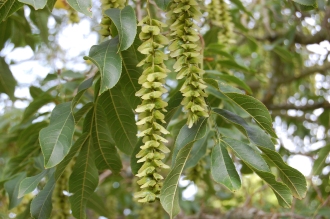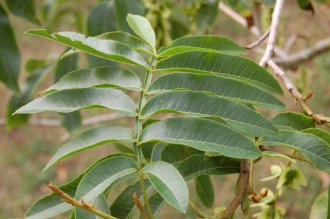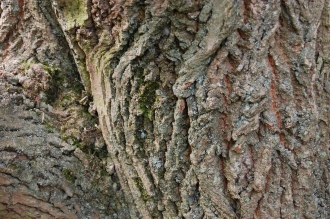Position: Full sun
Flowering period: Summer
Soil: Moist, well drained
Eventual Height: 20m
Eventual Spread: 15m
Hardiness: 6a, 6b, 7a, 7b, 8a, 8b, 9a
Family: Juglandaceae
Pterocarya stenoptera is a fast growing deciduous tree with a spreading habit. Its bright green leaves are even pinnate (rarely odd pinnate) and are up to 25cm long and composed of up to 25 leaflets. Its leaflets are elliptic to lanceolate with serrulate margins and are up to 12cm long and 3cm broad. In autumn its leaves turn yellow before they fall. Its trunk can reportedly reach up to 2.5 meters in diameter. Its grey bark has deep fissures which are coloured orange. Its monoecious flowers are pale green, racemose, up to 45cm long when female, 18cm long when male (however some studies have found functional hermaphroditic flowers) and wind pollinated. Its fruit are a nutlet, up to 7mm across with two wings up to 6mm across and ripen in late autumn to early winter.
Pterocarya stenoptera, commonly known as the Chinese Wingnut, is native to eastern Asia. In its native habitat it grows on mountainsides and along river and stream banks.
The etymological root of the binomial name Pterocarya is derived from ancient Greek meaning ‘winged-nut’. Stenoptera is from the Greek stenos meaning ‘narrow’ and pteron meaning ‘wing’.
The landscape architect may find Pterocarya stenoptera useful as an unusual specimen tree with attractive hanging fruit suitable for damp soils, particularly on river edges.
Ecologically, Pterocarya stenoptera fruit are attractive to some birds and mammals.
The Royal Horticultural Society have given the cultivar Pterocarya stenoptera ‘Fern Leaf ’ their prestigious Award of Garden Merit in 2012.
Pterocarya stenoptera prefers moist, fertile, well-drained soils. It tolerates most pH of soil.
Pterocarya stenoptera requires little maintenance. Pruning should be carried out during the summer months to prevent bleeding.








Leave a comment